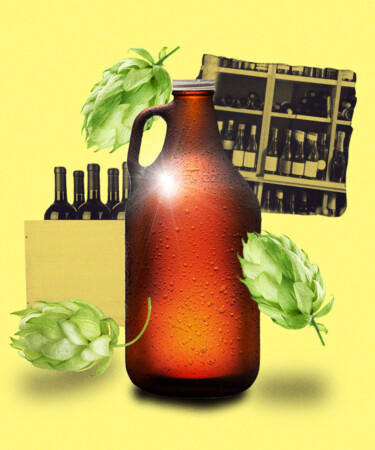In the late ‘70s, President Jimmy Carter signed a bill that changed the American homebrewing landscape for the better, giving beer hobbyists full license to brew their own beer, share ideas, and move the craft forward. But in the four decades prior to homebrewing’s legalization, beermakers were forced to turn to an unexpected source to help them illegally get their brew on: wine shops.
Like most stories about booze in the U.S. that take place in the 20th century, this tale begins with Prohibition. The Industrial Revolution saw homebrewing gain traction across the U.S. — and around the globe — but that came to a screeching halt in 1920. The Volstead Act, better known as the 18th Amendment, would prohibit the sale, manufacture, import, export, and transport of “intoxicating liquors.” But due to the amendment’s language, the government neglected to truly bring the gavel down on wine production: California still permitted the sale of grapes, there was no law against converting juice into wine, and households were allowed to make up to 200 gallons of wine for personal consumption.
California vintners quickly discovered these loopholes, and began manufacturing grape juice concentrate bricks to sell to the rest of the country. More often than not, Zinfandel was the grape of choice due to its hardy nature. The problem was that they couldn’t legally sell these bricks specifically for winemaking. But, if they sold them under another pretense, it was completely legal. So, every wine brick was stamped with a label that read: “Warning! Do not mix the contents of this package with five gallons of water and five pounds of sugar or it will ferment and become wine!”
Sure enough, people took the hint, and started using the bricks to make wine at home. By 1924, the price per ton of wine concentrate products was $375 — a 3,847 percent increase from the pre-Prohibition price tag of just $9.50. All the while, homebrewing culture struggled. Making wine was easier and more affordable than brewing beer, and the necessary ingredients to produce wine were much easier to get ahold of.
When Prohibition ended in 1933, laws eased up on home winemaking, but not homebrewing. To make matters worse for the then-budding beer community, the U.S. government would collect excise taxes on fermented malt beverages for the next 40-plus years — even if they were being produced for personal consumption. Homebrewers had to go underground to make the full-flavored beers they yearned for, setting up makeshift brewing systems in their garages, basements, and closets. And being the resourceful folks they were, homebrewers would get most of their equipment from winemaking supply stores. Similar to how modern day head shops sell bongs for “tobacco use only,” these supply stores were selling almost everything homebrewers needed to make beer. But even with those work-arounds, the evolution of craft beer was at a slight standstill — brewers still had to speak in hushed tones when it came to sharing knowledge and recipes, stymying the chance to push their shared practice forward.
But in the late ‘70s, things finally changed. Charlie Papazian, an elementary school teacher from Boulder, Colo., began teaching informal homebrewing classes out of his home in his spare hours. The course was called Log Boom Brewing, and roughly 1,000 people signed up during the 10 years that Papazian taught it, all while homebrewing was still illegal. His classes inspired a new wave of clandestine brewers who were getting all their gear from local winemaking shops — exactly as the lessons taught them to.
Unbeknownst to Papazian, politicians took notice. Some important people realized there was money to be made in homebrewing, so rather than cracking down on Papazian, a handful of government officials made efforts to ease up on the laws around the practice. In 1977, President Carter signed the House Resolution 1337, ushering in the era of tax-free, legal homebrewing. Papazian went on to found both the American Homebrew Association and the annual Great American Beer Festival. Shortly thereafter, he penned his iconic brewing guide, “The Complete Joy of Homebrewing.”
The rest, as they say, is history.
